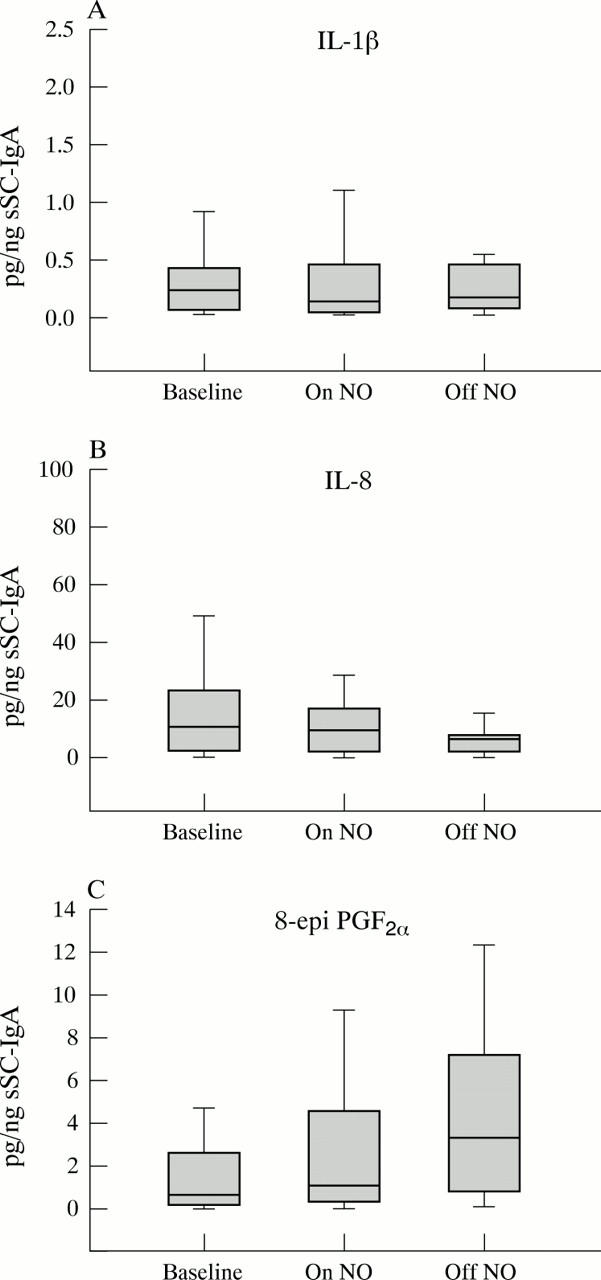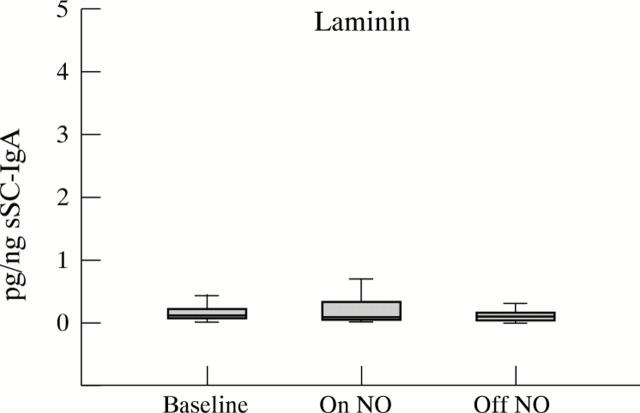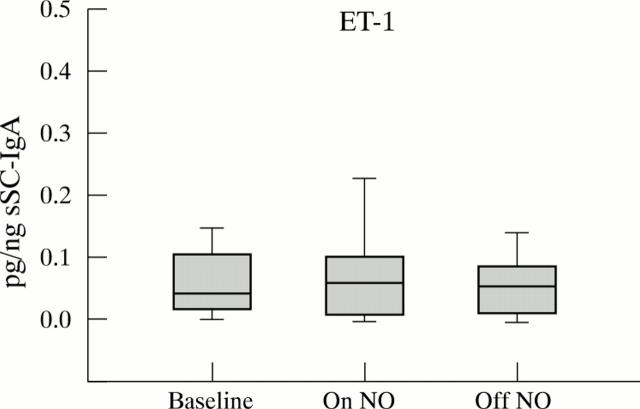Abstract
Background: Therapies for neonatal chronic lung disease (CLD) of prematurity have had limited success.
Aims: To determine whether inhaled nitric oxide (INO) administered to very low birthweight infants with developing CLD might improve oxygenation without adverse effects.
Methods: Subjects were 10–30 days of age, birth weight <1250 g, with developing or established CLD, and requiring mechanical ventilation with mean airway pressure ≥7 cm H2O and FIO2 ≥0.40. We monitored changes in oxygenation and FIO2 requirement during treatment with INO (initial dose 20 ppm). Tracheal aspirate samples obtained before, during, and after treatment were analysed for interleukin 1ß (IL-1ß), IL-8, 8-epi-prostaglandin F2α (8-epi-PGF2α), laminin, and endothelin 1 (ET-1) to assess any potential effects of INO on markers of inflammation peroxidation, basement membrane injury, or vasoactivity.
Results: Thirty three patients met entry criteria. Mean gestational age was 25 (SD 2) weeks; birth weight was 736 (190 g); age of study infants was 19 (6) days (range 9–29). Mean FIO2 decreased from baseline (0.75) to 0.58 at 72 hours. Duration of therapy was seven days. Tracheal aspirate concentrations of IL-1ß, IL-8, 8-epi-PGF2α, ET-1, and laminin were unchanged between baseline and 48 hours of INO, and 48 hours after discontinuation of INO. No new cases of, nor extension of, intraventricular haemorrhage occurred. Four infants died.
Conclusion: INO (≤20 ppm) improved oxygenation in most infants with early CLD, without inducing changes in markers of inflammatory or oxidative injury.
Full Text
The Full Text of this article is available as a PDF (167.0 KB).
Figure 1 .

Boxplot of levels of (A) IL-1ß, (B) IL-8, and (C) 8-epi-PGF2α, corrected for level of sSC-IgA before INO, after approximately 48 hours of INO, and after completion of INO treatment.
Figure 2 .
Boxplot of levels of laminin, corrected for level of sSC-IgA before INO, after approximately 48 hours of INO, and after completion of INO treatment.
Figure 3 .
Boxplot of levels of ET-1, corrected for level of sSC-IgA before INO, after approximately 48 hours of INO, and after completion of INO treatment.
Selected References
These references are in PubMed. This may not be the complete list of references from this article.
- Banks B. A., Seri I., Ischiropoulos H., Merrill J., Rychik J., Ballard R. A. Changes in oxygenation with inhaled nitric oxide in severe bronchopulmonary dysplasia. Pediatrics. 1999 Mar;103(3):610–618. doi: 10.1542/peds.103.3.610. [DOI] [PubMed] [Google Scholar]
- Benatar A., Clarke J., Silverman M. Pulmonary hypertension in infants with chronic lung disease: non-invasive evaluation and short term effect of oxygen treatment. Arch Dis Child Fetal Neonatal Ed. 1995 Jan;72(1):F14–F19. doi: 10.1136/fn.72.1.f14. [DOI] [PMC free article] [PubMed] [Google Scholar]
- Cheung P. Y., Peliowski A., Robertson C. M. The outcome of very low birth weight neonates (</=1500 g) rescued by inhaled nitric oxide: neurodevelopment in early childhood. J Pediatr. 1998 Dec;133(6):735–739. doi: 10.1016/s0022-3476(98)70142-8. [DOI] [PubMed] [Google Scholar]
- Chollet-Martin S., Gatecel C., Kermarrec N., Gougerot-Pocidalo M. A., Payen D. M. Alveolar neutrophil functions and cytokine levels in patients with the adult respiratory distress syndrome during nitric oxide inhalation. Am J Respir Crit Care Med. 1996 Mar;153(3):985–990. doi: 10.1164/ajrccm.153.3.8630584. [DOI] [PubMed] [Google Scholar]
- Cuthbertson B. H., Galley H. F., Webster N. R. The effects of nitric oxide and peroxynitrite on interleukin-8 and elastase from lipopolysaccharide-stimulated whole blood. Anesth Analg. 1998 Feb;86(2):427–431. doi: 10.1097/00000539-199802000-00039. [DOI] [PubMed] [Google Scholar]
- Goil S., Truog W. E., Barnes C., Norberg M., Rezaiekhaligh M., Thibeault D. Eight-epi-PGF2alpha: a possible marker of lipid peroxidation in term infants with severe pulmonary disease. J Pediatr. 1998 Feb;132(2):349–351. doi: 10.1016/s0022-3476(98)70459-7. [DOI] [PubMed] [Google Scholar]
- Jacob S. V., Coates A. L., Lands L. C., MacNeish C. F., Riley S. P., Hornby L., Outerbridge E. W., Davis G. M., Williams R. L. Long-term pulmonary sequelae of severe bronchopulmonary dysplasia. J Pediatr. 1998 Aug;133(2):193–200. doi: 10.1016/s0022-3476(98)70220-3. [DOI] [PubMed] [Google Scholar]
- Kinsella J. P., Parker T. A., Galan H., Sheridan B. C., Halbower A. C., Abman S. H. Effects of inhaled nitric oxide on pulmonary edema and lung neutrophil accumulation in severe experimental hyaline membrane disease. Pediatr Res. 1997 Apr;41(4 Pt 1):457–463. doi: 10.1203/00006450-199704000-00002. [DOI] [PubMed] [Google Scholar]
- Kinsella J. P., Walsh W. F., Bose C. L., Gerstmann D. R., Labella J. J., Sardesai S., Walsh-Sukys M. C., McCaffrey M. J., Cornfield D. N., Bhutani V. K. Inhaled nitric oxide in premature neonates with severe hypoxaemic respiratory failure: a randomised controlled trial. Lancet. 1999 Sep 25;354(9184):1061–1065. doi: 10.1016/s0140-6736(99)03558-8. [DOI] [PubMed] [Google Scholar]
- Kotecha S., Wilson L., Wangoo A., Silverman M., Shaw R. J. Increase in interleukin (IL)-1 beta and IL-6 in bronchoalveolar lavage fluid obtained from infants with chronic lung disease of prematurity. Pediatr Res. 1996 Aug;40(2):250–256. doi: 10.1203/00006450-199608000-00010. [DOI] [PubMed] [Google Scholar]
- Kuo H. P., Hwang K. H., Lin H. C., Wang C. H., Lu L. C. Effect of endogenous nitric oxide on tumour necrosis factor-alpha-induced leukosequestration and IL-8 release in guinea-pigs airways in vivo. Br J Pharmacol. 1997 Sep;122(1):103–111. doi: 10.1038/sj.bjp.0701338. [DOI] [PMC free article] [PubMed] [Google Scholar]
- Lönnqvist P. A., Jonsson B., Winberg P., Frostell C. G. Inhaled nitric oxide in infants with developing or established chronic lung disease. Acta Paediatr. 1995 Oct;84(10):1188–1192. doi: 10.1111/j.1651-2227.1995.tb13522.x. [DOI] [PubMed] [Google Scholar]
- Niu J. O., Munshi U. K., Siddiq M. M., Parton L. A. Early increase in endothelin-1 in tracheal aspirates of preterm infants: correlation with bronchopulmonary dysplasia. J Pediatr. 1998 Jun;132(6):965–970. doi: 10.1016/s0022-3476(98)70392-0. [DOI] [PubMed] [Google Scholar]
- Potter C. F., Dreshaj I. A., Haxhiu M. A., Stork E. K., Chatburn R. L., Martin R. J. Effect of exogenous and endogenous nitric oxide on the airway and tissue components of lung resistance in the newborn piglet. Pediatr Res. 1997 Jun;41(6):886–891. doi: 10.1203/00006450-199706000-00014. [DOI] [PubMed] [Google Scholar]
- Rindfleisch M. S., Hasday J. D., Taciak V., Broderick K., Viscardi R. M. Potential role of interleukin-1 in the development of bronchopulmonary dysplasia. J Interferon Cytokine Res. 1996 May;16(5):365–373. doi: 10.1089/jir.1996.16.365. [DOI] [PubMed] [Google Scholar]
- Shenai J. P. Vitamin A supplementation in very low birth weight neonates: rationale and evidence. Pediatrics. 1999 Dec;104(6):1369–1374. doi: 10.1542/peds.104.6.1369. [DOI] [PubMed] [Google Scholar]
- Singer L., Yamashita T., Lilien L., Collin M., Baley J. A longitudinal study of developmental outcome of infants with bronchopulmonary dysplasia and very low birth weight. Pediatrics. 1997 Dec;100(6):987–993. doi: 10.1542/peds.100.6.987. [DOI] [PMC free article] [PubMed] [Google Scholar]
- Subhedar N. V., Ryan S. W., Shaw N. J. Open randomised controlled trial of inhaled nitric oxide and early dexamethasone in high risk preterm infants. Arch Dis Child Fetal Neonatal Ed. 1997 Nov;77(3):F185–F190. doi: 10.1136/fn.77.3.f185. [DOI] [PMC free article] [PubMed] [Google Scholar]
- Thomassen M. J., Buhrow L. T., Connors M. J., Kaneko F. T., Erzurum S. C., Kavuru M. S. Nitric oxide inhibits inflammatory cytokine production by human alveolar macrophages. Am J Respir Cell Mol Biol. 1997 Sep;17(3):279–283. doi: 10.1165/ajrcmb.17.3.2998m. [DOI] [PubMed] [Google Scholar]
- Truog W. E., Norberg M., Thibeault D. W. Effects of 8-epi-prostaglandin F2 alpha and U46,619 on pulmonary hemodynamics in piglets. Biol Neonate. 1997;71(5):306–316. doi: 10.1159/000244430. [DOI] [PubMed] [Google Scholar]
- Van Meurs K. P., Rhine W. D., Asselin J. M., Durand D. J. Response of premature infants with severe respiratory failure to inhaled nitric oxide. Preemie NO Collaborative Group. Pediatr Pulmonol. 1997 Nov;24(5):319–323. doi: 10.1002/(sici)1099-0496(199711)24:5<319::aid-ppul3>3.0.co;2-d. [DOI] [PubMed] [Google Scholar]
- Villarete L. H., Remick D. G. Nitric oxide regulation of interleukin-8 gene expression. Shock. 1997 Jan;7(1):29–35. doi: 10.1097/00024382-199701000-00003. [DOI] [PubMed] [Google Scholar]




